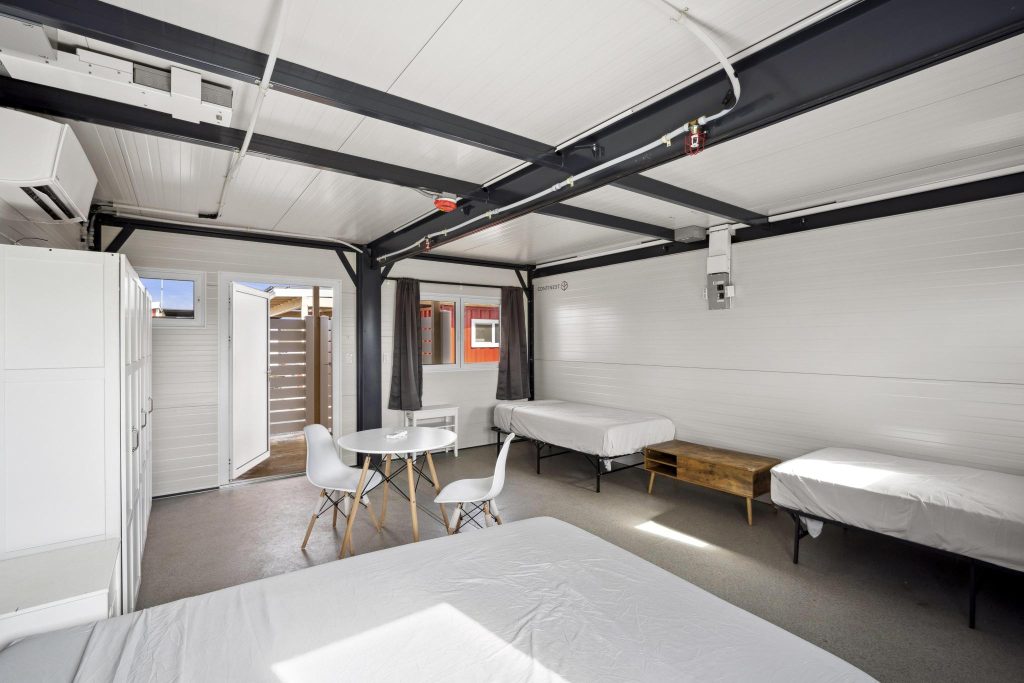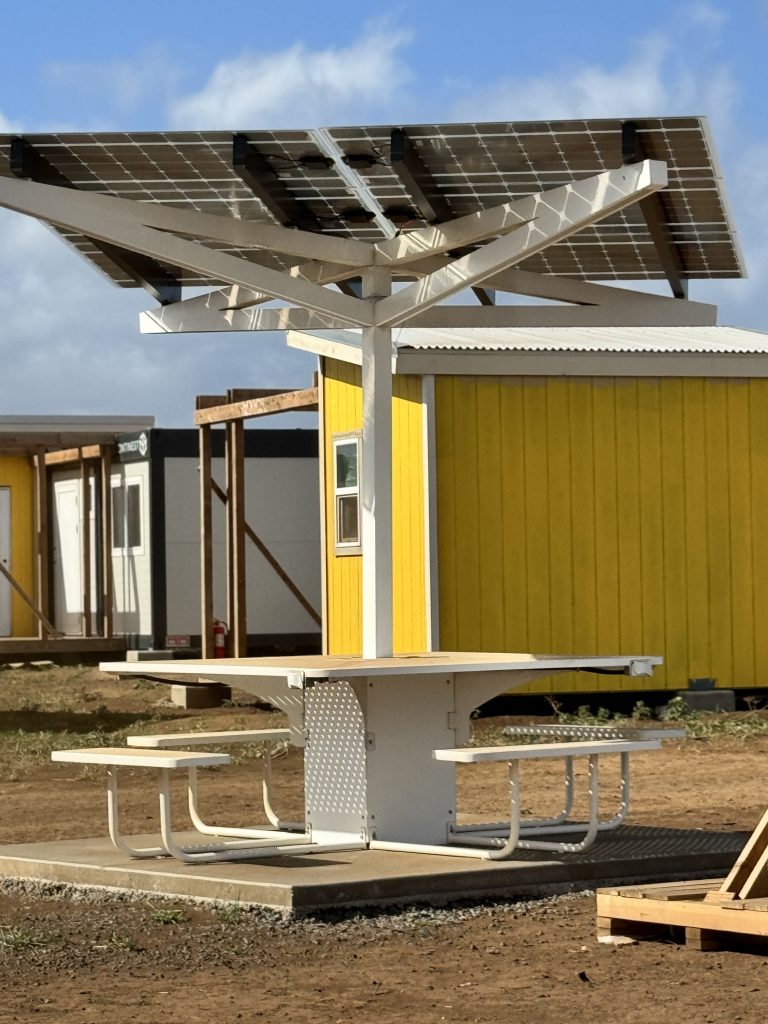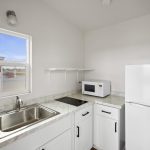Delays keep wildfire survivors from occupying housing at ʻOhana Hope Village

Nearly a year after the Maui wildfires, about 300 wildfire survivors are still waiting for the opportunity to move into 72 units at the ʻOhana Hope Village across from King’s Cathedral in Kahului.
“These folks have been living in hotels, with family and friends, for a year, and a vast majority were renters in multigenerational homes,” said David Sellers, Hawaiʻi Off Grid principal architect. “We need everyone to understand that there is a dire need for housing – just like before the fires. We know that thousands of people couldn’t wait any longer and have already left Maui. We need to be building these units faster.”
ʻOhana Hope Village is a midterm housing solution for those who lost their homes. The project is spearheaded by the Family Life Center, using 10-acres near the intersection of Maui Veterans Highway and Puʻunēnē Ave. The land is leased from King’s Cathedral, and the project is designed by Hawaiʻi Off Grid.
Many challenges have delayed occupancy of the temporary housing project. These include funding, access to infrastructure and permitting for temporary structures.
The project has run into infrastructure capacity challenges, a lack of water access and short staffing in government agencies that manage and process permits, Sellers said. Alexander & Baldwin has a private waterline on the property, but efforts to gain access to it have been unsuccessful, he said.
‘Ohana Hope Village’s backup plan for water is to hire a contractor to conduct horizontal drilling under Maui Veterans Memorial Highway from the project to a water meter near the Zippy’s restaurant. A contractor has been selected and is expected to begin work in the first or second week of September, Sellers said. The project has permits, but it is only partially paid for.
Permits for 16 temporary housing units were granted in early May, according to Maui County. These units are serviced by an onsite water holding tank.
“Historically, lack of infrastructure remains one of the biggest hurdles for new developments on Maui,” according to a Maui County statement received via email. “With ‘Ohana Hope Village, the primary challenge is lack of existing or planned infrastructure and access routes that meet health and safety standards. County of Maui is in full support of this project and is awaiting the opportunity to conduct additional inspection and permitting as needed.”
Seller said the project also has had difficulty with lack of staffing at the State Historic Preservation Division, which is “involved in almost everything… anytime you disturb the ground.”
The division is so short-staffed that it takes months or years to get the agency to sign off on permits, he said.
As for the A&B waterline on the project property, Sellers said, Hawaiʻi Off Grid tried to get access to water there, but A&B officials were “hesitant and reluctant to do so.”
A&B would not put its conditions in writing, but oral representations included a requirement for the project to join, temporarily, a private hui that provides water to the A&B Business Park, Sellers said.
“They won’t respond to our emails or put conditions in writing,” he said. “There’s not much we can do.”
A&B Manager of Corporate Communications Andrea Galvin said: “We spoke to Family Life Center mid-March this year and offered to assist with a temporary solution. Our understanding is they would next pursue the necessary regulatory approvals to ensure that both the permanent and short-term water solution would be done safely. Because this effort involves access to water many people rely on for drinking and fire protection, we await confirmation from them of critical government, health and safety approvals.”
Sellers said Maui County has been “extremely supportive,” despite having its own problems with lack of staffing to review and process permits. The process for getting an emergency permit for temporary housing was not set up until November or December, he said.
Another major obstacle has been funding, Sellers said, adding that the project needs $5 million for completion. “The outpouring of generosity immediately after the fire was massive,” he said. But “since then, the world has moved on.”
Money is needed to complete water infrastructure at the project site, to pay for building materials and finish structures with electricity, plumbing, fire sprinklers and alarms, among other things, he said.
“We have the bones,” Sellers said, but there’s another two months ahead of full-time construction work needed for building six dwelling units around a community center with a laundry facility, a full-sized kitchen, a large space for family gatherings and more office and meeting space for wraparound services, such as child care.
As for wastewater, Sellers said the Wailuku-Kahului Wastewater Reclamation Facility is currently at capacity, and the temporary housing project can’t connect to that system. Instead, the project is building and installing 16 septic systems, also called Individual wastewater systems. These use beneficial bacteria to break down human waste, and then the wastewater is distributed through an absorption field, he said.
Many families who’ve been waiting for the ʻOhana Hope Village to come online continue to face uncertainty about housing, with rent relief ending and ineligibility for help from the Federal Emergency Management Agency.
“After the fires, we knew this was going to be a crisis, because we’ve been facing this housing crisis for years,” said Dr. Ashley Kelly, Family Life Center chief operating officer. “The fires just compounded it. We wanted to be part of the relief… We don’t let the grass grow under our feet. Our whole goal was to build homes as quickly as possible, without compromising quality. We’re doing this for families who have not been able to sleep, their lives have been in a constant upheaval. We want to give them that peace of mind.”
ʻOhana Hope Village came together out of a vision for the community: research-based best practices on housing for the houseless, trauma-informed design, infrastructure and buildout, and a longstanding mentality to put the needs of the fire survivors front and center, according to Hawaiʻi Off Grid.
“We wanted safety for our families, and we stood firm on that ground,” Kelly said. “We wanted an environment that was conducive to healing: 5 feet of noncombustibles around the dwelling and 10-foot minimum between homes; reducing the appearance of flammable materials; fire-retardant paint. These families had just come out of a traumatic experience, so this work was worth it.”
In May, Sellers led a Homeowners Rebuilding Informational Workshop in Lahaina as president of AIA Maui. The presentation, in coordination with Hawaiʻi Off Grid and Council for Native Hawaiian Advancement, provided resources for homeowners on the rebuilding process.
For many, the process is completely new, and overwhelming. Hawaiʻi Off Grid and AIA Maui architects provided free, pre-approved building plans.
“AIA Maui wants to be a voice in the rebuilding process; they are experts at what they do,” said Megan Villa, Hawaiʻi Off Grid public relations and media coordinator. “Architects are becoming a part of the process of rebuilding, and we want them to be seen as integral voices – especially after natural disasters.”
For more information or to donate to the ʻOhana Hope Village project, visit: https://flcmaui.org/maui-disaster-relief-donation/



















